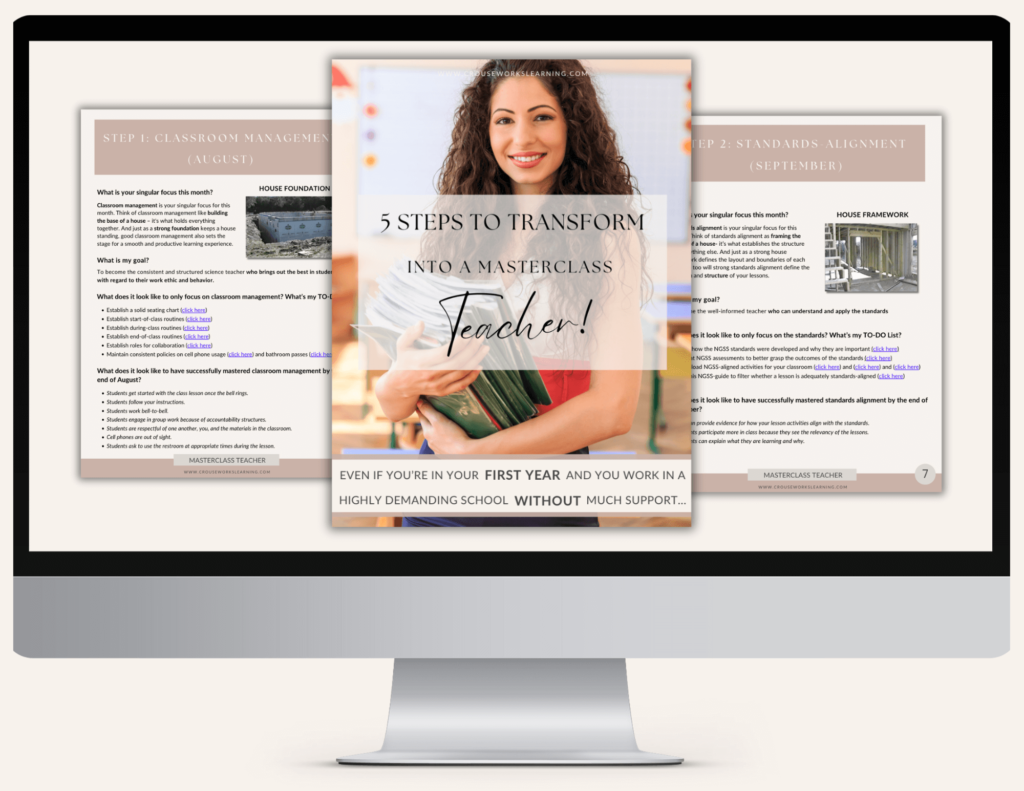Are you a teacher who feels anxious at the start of the school year when you hear statements like, “You’ve got to build relationships with your students…” and “Make sure you’re only doing culture-building activities the first few days…”
I know for me, I always struggled with statements like that. And I think that’s because, while yes, I absolutely agree that connecting with students is important… I think, so often as teachers, we associate culture-building with…
- Facilitating awkward icebreaker and get-to-know-you activities
- Being super engaging and relatable as a teacher
- Putting on a show for students, being extroverted
- Being comfortable navigating the gray area of socioemotional talks with kids.
- Skillfully balancing vulnerability with kids while still holding to boundaries and commanding respect.
And I don’t know about you, but even just reading that list right now starts to induce overwhelm!

For years and years as a teacher, I pushed myself out of my comfort zone. Making myself more relatable, extroverted, and fun for kids. And looking back on it, some of that was undoubtedly good for me. I needed to learn how to become more easy-going and relaxed at times. But truthfully, after years of pushing myself so hard to be someone I wasn’t, I inevitably hit a wall. During my 3rd, 4th, and 5th years of teaching- classroom lessons were starting to feel like big performances, having to suddenly turn myself “on” and climb onto stage every single day. And after a while, you know, you just can’t will yourself to do that anymore.
So that’s what this post is about. I hope this post will provide any secondary science teachers out there, who resonate with what I’m saying, with an alternative set of culture-building strategies for their classrooms. Culture-building strategies that allow you to connect with students, engage with their unique backgrounds and interests, and help students to buy into your classroom and lessons- all without having to put on a performance. Because, at the end of the day, the name of the game is teacher sustainability. And this means, as a teacher, you must develop systems and structures that will work for you in the long run.
So this blog post is for all my science teacher friends out there who are a bit more introverted, don’t looooove being center stage as a teacher, and get knots in their stomachs when they think about having to teach a lot of socioemotional lessons during homeroom/ advisory class 😉
TIP #1: Set up low-risk, easy-to-implement opportunities to learn about your students
The great news about culture-building is that at its heart, it’s really all about the student, not you. So take the pressure off yourself to share with students every relatable detail in the world about yourself. And just get to know your students!
One thing I always did feel comfortable with at the beginning of the school year was giving out surveys to students. Surveys are a great way of showing students you value them and care about what they care about without having to navigate the tricky waters of in-depth personal talk. You can learn more about what students are interested in and what their backgrounds are like. And you can give out surveys any time during the year! I often use surveys to ask students how their classes are going, what stresses they’re encountering on a day-to-day basis, or how I can make my class more comfortable for them. Surveys are a great way to connect with students because they provide a low-risk opportunity for students to share things with you that they may not have otherwise been inclined to say out loud.
If you’re looking for ideas of easy, low-risk, get-to-know-you surveys (and other activities), here are some examples of things I’ve used…
NAME TENT ONE-PAGER ACTIVITY
This “Name Tent One-Pager” activity is meant for the start of the school year. It’s a free activity you can download from Spark Creativity on Teachers Pay Teachers (click here).
I modified the text slightly so it was more conducive for my high school students. It’s a great “get-to-know-you” activity to kick off the school year!
ALL-ABOUT-ME SURVEY
Here’s an “All About Me” survey I like to give students at the start of the school year. It includes all the questions that I most want to know about students before we start our year-long learning journey together.
TIP #2: Ask for meaningful feedback
I know, I know… this can be a tough one. As a teacher, after wholeheartedly pouring all of your time and energy (and often money) into your students and classroom, the last thing you want to do is hear feedback from students that the class isn’t fun enough or they don’t like the amount of homework you give them. I know, it’s tough! When it comes to their teachers, students sometimes miss the socioemotional train and do not stop to think about what they are saying and how it is coming across.
That’s why, over the years, I’ve stopped giving “open-ended” feedback surveys to students. Because I would just find that kids would write generic statements like, “You’re giving too much homework.” or “Can we do more fun stuff?” Which, don’t get me wrong, can certainly uncover truths about your class and are therefore helpful to a degree. But, when it really came down to it- the feedback did not give me much to go off of regarding specific, tangible actions I could take to facilitate learning better, maintain higher expectations, or better support students in their struggles. I think students simply struggle to pull meaningful feedback out of thin air. So they write whatever pops into their mind first, like, “No homework,” and “Being able to use their phones.”
So, that’s why, over time I learned to provide students with multiple-choice options on my feedback surveys or idea boxes. That way I could build them up to providing meaningful open-response type feedback.
Take a look at the example below!
TIP #3: Let students build connections with each other
Not super extroverted yourself? Don’t love small talk and chit-chat? Not the biggest fan of having the spotlight pointed at you? Well, good! Because you know who does love all of that? Some of your students! Oh man, I can’t tell you the amount of times I’ve thanked my lucky stars for having certain students in my class. Because you know (and I very well know) that there are many, manyyyyy extroverted students out there who will happily talk to a brick wall until the cows come home.
So utilize those special students! Place them strategically in groups.
And it’s even better if you take the time to tell them that! Say something like, “Hey, thanks for being so good at engaging everyone around you. I hope you know I see you as a leader in my classroom. And if it’s alright with you, I’d like to lean on you at times to connect with some of the students here who aren’t as naturally comfortable with things as you are. Is that okay?” Talk about a win-win. That student feels great being seen as a leader, and you feel comforted knowing you don’t have to carry the “student engagement torch” all by yourself!

TIP #4: Use multiple modalities of learning
Do you know what students enjoy in the classroom… more than we even know as teachers? They enjoy it when we switch up the pace! So, get some new activities going to liven things up a bit.
Been working on paper for the past few days? Go to digital and bust out those Chromebooks! Had kids working in groups for the past week? Let them fly solo with some independent work! Doing a lot of labs recently? Slow things down with some paper and pencil inquiry work.
It took me a long time to realize that students didn’t need to do physical, hands-on, collaborative activities every day. In fact, when you do that, it quickly becomes exhausting for both you and them. Students much prefer that you switch up the pace occasionally.
Now, how does all this relate to culture-building, you might ask? Easy- switching up activities is a great way to incorporate multiple learning modalities. Yes, you heard me right- the next time you are asked to turn in a lesson plan, and you find yourself changing up activities, you should find a way to insert that phrase somewhere… “multiple learning modalities.” It’s a winner. And it’s true!
When you have a mixture of activities that are collaborative vs. independent, paper vs. digital, hands-on labs vs. minds-on inquiry, you will not only keep kids engaged, but you will also allow them a chance to shine in whichever modality of learning they prefer most. What builds more culture than that in a classroom?!
As teachers, it’s crucial that we play to our students’ strengths and give them as many opportunities as we can to experience different learning methods.
Pssst…. not to mention, any time you can have more fun in your classroom, that builds culture like nobody’s business!

TIP #5: Include voice and choice
Okay, before we begin with this strategy, I just want to preface real quick… New teachers, please take this strategy with a grain of salt. If you are a new teacher, you truly have enough on your plate trying to put together 1 solid throughline of a lesson, much less a lesson with 5 tangential outcomes. It is enough for you to focus on writing concrete objectives, managing your classroom effectively, and providing effective lesson scaffolding. So, if you are new to teaching, it’s okay to hold off on this strategy until you’ve got the capacity for it.
However, for teachers who are up for it, when you can provide voice and choice to students on the topics they learn about, the types of projects they complete, and the ways they can demonstrate their mastery to you, that is a recipe for a happy classroom. And the best news is providing voice and choice to students does not have to be this all-or-none thing. At any point in an assignment, you can provide choices to students. Do they want to work with another student or independently? Do they want to write up their finished product on paper or digitally? Do they want to review for the test using Khan Academy or by re-reading their notes?
Sometimes, as teachers, we see creating options for students as going from making 1 lesson to 5 lessons. But it does not have to be that way. Anytime you add a little bit of choice for students, you get a lot more back in buy-in!

BONUS TIP #6: Set high expectations for your students
At the end of the day, the single best thing you can do for your students to build classroom culture is to have high expectations of them. Students see right through us as teachers- whether we like to admit it or not. They know when we lack confidence in our lessons, are putting on a show for admin, or having the living daylights drained from us over cell phone usage. I promise you, your students can read you like a book.
So, this becomes important inner work on your part as a teacher. Challenging the mindset you walk into the classroom with- especially your assumptions, biases, and longstanding beliefs on things. Now, that’s not to say students won’t irk your last nerves some days- and won’t whittle you down in a relentless war of attrition- to the point that you, quite frankly, feel like you’ve got “compromise central” stamped to your forehead. But that’s to be expected. Kids are kids- no matter what age they are. After they learn your rules, they will figure out how to ever so slightly bend those rules so you can’t scold them, can’t make them feel guilty, and can’t get them to quit. That’s just how they operate.
But, putting all that aside- the real question is- do you fundamentally know, deep down, in your heart of hearts, that every child (with the right love and academic support and consistent circumstances) is capable of successfully meeting the standards in your class? Do you see the potential in every child to have a successful life and career after high school? Because whether you do or don’t, your students will be able to tell.
Our actions and words, well-intentioned or not, will always convey our truest inner thoughts. And that’s a good thing! Because it’s always important to get to the roots of our ideas and perspectives on the world. As our dear neighborhood friend Mister Fred Rogers said, “Anything that is human is mentionable, and anything that is mentionable is manageable.” So, if you’re struggling to hold students to high expectations, it’s okay to talk about it, and in fact, you should talk about it with someone who can help you, like an instructional coach or department chair. I promise every thought you’ve had is not unique to you, and you are not alone in it!

To wrap up...
Alas, so culture building. We’ve covered a lot in this post, haven’t we? Didn’t go quite the way you expected when you first opened up this post, did it?
You see, I bet I snagged you on that catchy blog title and picture, didn’t I? But wasn’t it worth it?! I hope you’ve found some inspiration in this post. More importantly, I hope you’ve found some practical, realistic strategies to help you have win-win culture-building interactions with your kids starting this week!

P.S. If you are a first year teacher who is drowning in all the demands at your school, and culture-building is just ONE of a thousand concerns you are juggling right now… Have NO fear because I have a solution for that as well! 😉
In my FREE “5 Steps to a Masterclass Teacher” guidebook you will find alllllll my best-kept teaching secrets and classroom hacks to put you on the FAST-TRACK for turning around your school year! It’s a step-by-step guide that is guaranteed to have you feeling fired-up, confident, and excited again to being a teacher.
Download the FREE guidebook now to start turning that newbie-teacher frown upside down!


